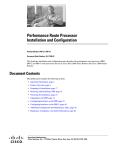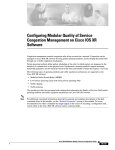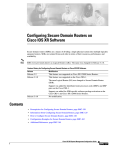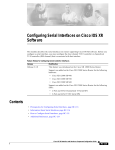Download Cisco Systems SMC-169 User's Manual
Transcript
Implementing NTP on Cisco IOS XR Software
Network Time Protocol (NTP) is a protocol designed to time-synchronize devices within a network. The
Cisco IOS XR software implements NTPv4. NTPv4 retains backwards compatibility with the older
versions of NTP, including NTPv3 and NTPv2 but excluding NTPv1, which has been discontinued due
to security vulnerabilities.
This module describes the new and revised tasks you need to implement NTP on your Cisco IOS XR
network.
Note
For more information about NTP on the Cisco IOS XR software and complete descriptions of the NTP
commands listed in this module, you can refer to the “Related Documents” section of this module. To
locate documentation for other commands that might appear in the course of running a configuration
task, search online in the Cisco IOS XR software master command index.
Feature History for Implementing NTP on Cisco IOS XR Software Contents
Release
Modification
Release 2.0
This feature was introduced on the Cisco CRS-1.
Release 3.0
No modification.
Release 3.2
Support was added for the Cisco XR 12000 Series Router.
Release 3.3.0
No modification.
Contents
•
Prerequisites for Implementing NTP on Cisco IOS XR Software, page SMC-170
•
Information About Implementing NTP on Cisco IOS XR Software, page SMC-170
•
How to Implement NTP on Cisco IOS XR Software, page SMC-171
•
Configuration Examples for Implementing NTP on Cisco IOS XR Software, page SMC-187
•
Additional References, page SMC-191
Cisco IOS XR System Management Configuration Guide
SMC-169
Implementing NTP on Cisco IOS XR Software
Prerequisites for Implementing NTP on Cisco IOS XR Software
Prerequisites for Implementing NTP on Cisco IOS XR Software
The following prerequisites are required to implement NTP in your network operating center (NOC):
•
You must be in a user group associated with a task group that includes the proper task IDs for CDP
commands. Task IDs for commands are listed in the Cisco IOS XR Task ID Reference Guide.
For detailed information about user groups and task IDs, see the Configuring AAA Services on
Cisco IOS XR Software module of the Cisco IOS XR System Security Configuration Guide.
•
You must have connectivity with at least one server that is running NTP.
Information About Implementing NTP on Cisco IOS XR Software
To implement NTP, you need to understand the following concept:
•
“NTP Functional Overview” section on page SMC-170
NTP Functional Overview
NTP synchronizes timekeeping among a set of distributed time servers and clients. This synchronization
allows events to be correlated when system logs are created and other time-specific events occur.
NTP uses the User Datagram Protocol (UDP) as its transport protocol. All NTP communication uses
Coordinated Universal Time (UTC). An NTP network usually receives its time from an authoritative
time source, such as a radio clock or an atomic clock attached to a time server. NTP distributes this time
across the network. NTP is extremely efficient; no more than one packet per minute is necessary to
synchronize two machines to within a millisecond of each other.
NTP uses the concept of a “stratum” to describe how many NTP “hops” away a machine is from an
authoritative time source. A “stratum 1” time server typically has an authoritative time source (such as
a radio or atomic clock, or a GPS time source) directly attached, a “stratum 2” time server receives its
time via NTP from a “stratum 1” time server, and so on.
NTP avoids synchronizing to a machine whose time may not be accurate in two ways. First, NTP will
never synchronize to a machine that is not in turn synchronized itself. Second, NTP compares the time
reported by several machines and does not synchronize to a machine whose time is significantly different
than the others, even if its stratum is lower. This strategy effectively builds a self-organizing tree of NTP
servers.
The Cisco implementation of NTP does not support stratum 1 service; in other words, it is not possible
to connect to a radio or atomic clock (for some specific platforms, however, you can connect a GPS
time-source device). We recommend that time service for your network be derived from the public NTP
servers available in the IP Internet.
If the network is isolated from the Internet, the Cisco implementation of NTP allows a machine to be
configured so that it acts as though it is synchronized via NTP, when in fact it has determined the time
using other means. Other machines can then synchronize to that machine via NTP.
A number of manufacturers include NTP software for their host systems, and a publicly available version
for systems running UNIX and its various derivatives is also available. This software also allows
UNIX-derivative servers to acquire the time directly from an atomic clock, which would subsequently
propagate time information along to Cisco routers.
Cisco IOS XR System Management Configuration Guide
SMC-170
Implementing NTP on Cisco IOS XR Software
How to Implement NTP on Cisco IOS XR Software
The communications between machines running NTP (known as “associations”) are usually statically
configured; each machine is given the IP address of all machines with which it should form associations.
Accurate timekeeping is made possible by exchanging NTP messages between each pair of machines
with an association.
However, in a LAN environment, NTP can be configured to use IP broadcast messages instead. This
alternative reduces configuration complexity, because each machine can simply be configured to send or
receive broadcast messages. However, the accuracy of timekeeping is marginally reduced because the
information flow is one-way only.
The time kept on a machine is a critical resource, so we strongly recommend that you use the security
features of NTP to avoid the accidental or malicious setting of incorrect time. Two mechanisms are
available: an access list-based restriction scheme and an encrypted authentication mechanism.
When multiple sources of time (VINES, hardware clock, manual configuration) are available, NTP is
always considered to be more authoritative. NTP time overrides the time set by any other method.
How to Implement NTP on Cisco IOS XR Software
This section contains the following procedures:
•
“Configuring Poll-Based Associations” section on page SMC-171 (optional)
•
“Configuring Broadcast-Based NTP Associations” section on page SMC-173 (optional)
•
“Configuring NTP Access Groups” section on page SMC-175 (optional)
•
“Configuring NTP Authentication” section on page SMC-178 (optional)
•
“Disabling NTP Services on a Specific Interface” section on page SMC-180 (optional)
•
“Configuring the Source IP Address for NTP Packets” section on page SMC-182 (optional)
•
“Configuring the System as an Authoritative NTP Server” section on page SMC-184 (optional)
•
“Updating the Hardware Clock” section on page SMC-185 (optional)
•
“Verifying the Status of the External Reference Clock” section on page SMC-187 (optional)
Configuring Poll-Based Associations
This task explains how to configure poll-based NTP associations.
Note
No specific command enables NTP; the first NTP configuration command that you issue enables NTP.
Poll-Based Associations
Networking devices running NTP can be configured to operate in variety of association modes when
synchronizing time with reference time sources. There are two ways that a networking device can obtain
time information on a network: by polling host servers and by listening to NTP broadcasts. In this task,
we will focus on the poll-based association modes. Broadcast-based NTP associations will be discussed
in the next task, “Configuring Broadcast-Based NTP Associations.”
Cisco IOS XR System Management Configuration Guide
SMC-171
Implementing NTP on Cisco IOS XR Software
How to Implement NTP on Cisco IOS XR Software
The following are two most commonly used, poll-based association modes:
•
Client mode
•
Symmetric active mode
The client and the symmetric active modes should be used when NTP is required to provide a high level
of time accuracy and reliability.
When a networking device is operating in the client mode, it polls its assigned time serving hosts for the
current time. The networking device then picks a host from all the polled time servers to synchronize
with. Because the relationship that is established in this case is a client-host relationship, the host does
not capture or use any time information sent by the local client device. This mode is most suited for
file-server and workstation clients that are not required to provide any form of time synchronization to
other local clients. Use the server command to individually specify the time-serving hosts that you want
your networking device to consider synchronizing with and to set your networking device to operate in
the client mode.
When a networking device is operating in the symmetric active mode, it polls its assigned time-serving
hosts for the current time and it responds to polls by its hosts. Because this is a peer-to-peer relationship,
the host also retains time-related information about the local networking device that it is communicating
with. This mode should be used when there is a number of mutually redundant servers that are
interconnected via diverse network paths. Most stratum 1 and stratum 2 servers on the Internet today
adopt this form of network setup. Use the peer command to individually specify the time-serving hosts
that you want your networking device to consider synchronizing with and to set your networking device
to operate in the symmetric active mode.
SUMMARY STEPS
1.
configure
2.
ntp
3.
server ip-address [version number] [key key-id] [minpoll interval] [maxpoll interval] [source
interface-type interface-instance] [prefer]
4.
peer ip-address [version number] [key key-id] [minpoll interval] [maxpoll interval] [source
interface-type interface-instance] [prefer]
5.
end
or
commit
DETAILED STEPS
Step 1
Command or Action
Purpose
configure
Enters global configuration mode.
Example:
RP/0/RP0/CPU0:router# configure
Step 2
Enters NTP configuration mode.
ntp
Example:
RP/0/RP0/CPU0:router(config)# ntp
Cisco IOS XR System Management Configuration Guide
SMC-172
Implementing NTP on Cisco IOS XR Software
How to Implement NTP on Cisco IOS XR Software
Step 3
Command or Action
Purpose
server ip-address [version number] [key key-id]
[minpoll interval] [maxpoll interval] [source
interface-type interface-instance] [prefer]
Forms a server association with another system.
Example:
RP/0/RP0/CPU0:router(config-ntp)# server
172.16.22.44 minpoll 8 maxpoll 12
Step 4
peer ip-address [version number] [key key-id]
[minpoll interval] [maxpoll interval] [source
interface-type interface-instance] [prefer]
Forms a peer association with another system.
Example:
RP/0/RP0/CPU0:router(config-ntp)# peer
192.168.22.33 minpoll 8 maxpoll 12 source pos
0/0/0/1
Step 5
Saves configuration changes.
end
or
commit
When you issue the end command, the system prompts
you to commit changes:
Example:
Uncommitted changes found, commit them before
exiting(yes/no/cancel)?
[cancel]:
•
RP/0/RP0/CPU0:router(config)# end
or
– Entering yes saves configuration changes to the
RP/0/RP0/CPU0:router(config)# commit
running configuration file, exits the configuration
session, and returns the router to EXEC mode.
– Entering no exits the configuration session and
returns the router to EXEC mode without
committing the configuration changes.
– Entering cancel leaves the router in the current
configuration session without exiting or
committing the configuration changes.
•
Use the commit command to save the configuration
changes to the running configuration file and remain
within the configuration session.
Configuring Broadcast-Based NTP Associations
This task explains how to configure broadcast-based NTP associations.
Note
No specific command enables NTP; the first NTP configuration command that you issue enables NTP.
Broadcast-Based NTP Associations
Broadcast-based NTP associations should be used when time accuracy and reliability requirements are
modest and if your network is localized and has a large number of clients (more than 20).
Broadcast-based NTP associations also are recommended for use on networks that have limited
bandwidth, system memory, or CPU resources.
Cisco IOS XR System Management Configuration Guide
SMC-173
Implementing NTP on Cisco IOS XR Software
How to Implement NTP on Cisco IOS XR Software
When a networking device is operating in the broadcastclient mode, it does not engage in any polling.
Instead, it listens for NTP broadcast packets transmitted by broadcast time servers. Consequently, time
accuracy can be marginally reduced, because time information flows only one way.
Use the broadcast client command to set your networking device to listen for NTP broadcast packets
propagated through a network. For broadcastclient mode to work, the broadcast server and its clients
must be located on the same subnet. The time server that is transmitting NTP broadcast packets must be
enabled on the interface of the given device using the broadcast command.
SUMMARY STEPS
1.
configure
2.
ntp
3.
broadcastdelay microseconds
4.
interface type instance
5.
broadcast client
6.
broadcast [destination ip-address] [key key-id] [version number]
7.
end
or
commit
DETAILED STEPS
Step 1
Command or Action
Purpose
configure
Enters global configuration mode.
Example:
RP/0/RP0/CPU0:router# configure
Step 2
Enters NTP configuration mode.
ntp
Example:
RP/0/RP0/CPU0:router(config)# ntp
Step 3
broadcastdelay microseconds
Adjusts the estimated round-trip delay for NTP broadcasts.
Example:
RP/0/RP0/CPU0:router(config-ntp)#
broadcastdelay 5000
Step 4
interface type instance
Enters NTP interface configuration mode.
Example:
RP/0/RP0/CPU0:router(config-ntp)# interface POS
0/1/0/0
Step 5
broadcast client
Example:
RP/0/RP0/CPU0:(config-ntp-int)# broadcast
client
Cisco IOS XR System Management Configuration Guide
SMC-174
Configures the specified interface to receive NTP broadcast
packets.
Implementing NTP on Cisco IOS XR Software
How to Implement NTP on Cisco IOS XR Software
Step 6
Command or Action
Purpose
broadcast [destination ip-address] [key key-id]
[version number]
Configures the specified interface to send NTP broadcast
packets.
Example:
RP/0/RP0/CPU0:(config-ntp-int)# broadcast
destination 10.50.32.149
Step 7
Saves configuration changes.
end
or
commit
When you issue the end command, the system prompts
you to commit changes:
Example:
Uncommitted changes found, commit them before
exiting(yes/no/cancel)?
[cancel]:
•
RP/0/RP0/CPU0:router(config)# end
or
– Entering yes saves configuration changes to the
RP/0/RP0/CPU0:router(config)# commit
running configuration file, exits the configuration
session, and returns the router to EXEC mode.
– Entering no exits the configuration session and
returns the router to EXEC mode without
committing the configuration changes.
– Entering cancel leaves the router in the current
configuration session without exiting or
committing the configuration changes.
•
Use the commit command to save the configuration
changes to the running configuration file and remain
within the configuration session.
Configuring NTP Access Groups
This task explains how to configure NTP access groups.
Note
No specific command enables NTP; the first NTP configuration command that you issue enables NTP.
NTP Access Groups
The access list-based restriction scheme allows you to grant or deny certain access privileges to an entire
network, a subnet within a network, or a host within a subnet.
The access group options are scanned in the following order, from least restrictive to most restrictive:
1.
peer—Allows time requests and NTP control queries and allows the system to synchronize itself to
a system whose address passes the access list criteria.
2.
serve—Allows time requests and NTP control queries, but does not allow the system to synchronize
itself to a system whose address passes the access list criteria.
3.
serve-only—Allows only time requests from a system whose address passes the access list criteria.
4.
query-only—Allows only NTP control queries from a system whose address passes the access list
criteria.
Cisco IOS XR System Management Configuration Guide
SMC-175
Implementing NTP on Cisco IOS XR Software
How to Implement NTP on Cisco IOS XR Software
If the source IP address matches the access lists for more than one access type, the first type is granted.
If no access groups are specified, all access types are granted to all systems. If any access groups are
specified, only the specified access types are granted.
For details on NTP control queries, see RFC 1305 (NTP version 3).
SUMMARY STEPS
1.
configure
2.
ntp
3.
access-group {peer | query-only | serve | serve-only} access-list-name
4.
end
or
commit
DETAILED STEPS
Step 1
Command or Action
Purpose
configure
Enters global configuration mode.
Example:
RP/0/RP0/CPU0:router# configure
Step 2
Enters NTP configuration mode.
ntp
Example:
RP/0/RP0/CPU0:router(config)# ntp
Cisco IOS XR System Management Configuration Guide
SMC-176
Implementing NTP on Cisco IOS XR Software
How to Implement NTP on Cisco IOS XR Software
Step 3
Command or Action
Purpose
access-group {peer | query-only | serve |
serve-only} access-list-name
Creates an access group and applies a basic IP access list to
it.
Example:
RP/0/RP0/CPU0:router(config-ntp)# access-group
peer access1
Step 4
end
or
Saves configuration changes.
commit
When you issue the end command, the system prompts
you to commit changes:
Example:
Uncommitted changes found, commit them before
exiting(yes/no/cancel)?
[cancel]:
•
RP/0/RP0/CPU0:router(config)# end
or
– Entering yes saves configuration changes to the
RP/0/RP0/CPU0:router(config)# commit
running configuration file, exits the configuration
session, and returns the router to EXEC mode.
– Entering no exits the configuration session and
returns the router to EXEC mode without
committing the configuration changes.
– Entering cancel leaves the router in the current
configuration session without exiting or
committing the configuration changes.
•
Use the commit command to save the configuration
changes to the running configuration file and remain
within the configuration session.
Cisco IOS XR System Management Configuration Guide
SMC-177
Implementing NTP on Cisco IOS XR Software
How to Implement NTP on Cisco IOS XR Software
Configuring NTP Authentication
This task explains how to configure NTP authentication.
Note
No specific command enables NTP; the first NTP configuration command that you issue enables NTP.
NTP Authentication
The encrypted NTP authentication scheme should be used when a reliable form of access control is
required. Unlike the access-list-based restriction scheme that is based on IP addresses, the encrypted
authentication scheme uses authentication keys and an authentication process to determine if NTP
synchronization packets sent by designated peers or servers on a local network are deemed as trusted,
before the time information that it carries along is accepted.
The authentication process begins from the moment an NTP packet is created. Cryptographic checksum
keys are generated using the MD5 Message Digest Algorithm and are embedded into the NTP
synchronization packet that is sent to a receiving client. When a packet is received by a client, its
cryptographic checksum key is decrypted and checked against a list of trusted keys. If authentication is
enabled and a key is trusted, the system is allowed to sync to the server that uses this key in its packets.
It is important to note that the encryption and decryption processes used in NTP authentication can be
very CPU-intensive and can seriously degrade the accuracy of the time that is propagated within a
network. If your network setup permits a more comprehensive model of access control, you should
consider the use of the access-list-based form of control instead.
After NTP authentication is properly configured, your networking device only synchronizes with and
provides synchronization to trusted time sources.
SUMMARY STEPS
1.
configure
2.
ntp
3.
authenticate
4.
authentication-key key-number md5 [clear | encrypted] key-name
5.
trusted-key key-number
6.
end
or
commit
Cisco IOS XR System Management Configuration Guide
SMC-178
Implementing NTP on Cisco IOS XR Software
How to Implement NTP on Cisco IOS XR Software
DETAILED STEPS
Step 1
Command or Action
Purpose
configure
Enters global configuration mode.
Example:
RP/0/RP0/CPU0:router# configure
Step 2
ntp
Enters NTP configuration mode.
Example:
RP/0/RP0/CPU0:router(config)# ntp
Step 3
authenticate
Enables the NTP authentication feature.
Example:
RP/0/RP0/CPU0:router(config-ntp)# authenticate
Step 4
authentication-key key-number md5 [clear |
encrypted] key-name
Defines the authentication keys.
•
Example:
Each key has a key number, a type, a value, and,
optionally, a name. Currently the only key type
supported is md5.
RP/0/RP0/CPU0:router(config-ntp)#
authentication-key 42 md5 clear key1
Step 5
trusted-key key-number
Defines trusted authentication keys.
•
Example:
If a key is trusted, this router only synchronizes to a
system that uses this key in its NTP packets.
RP/0/RP0/CPU0:router(config-ntp)# trusted-key
42
Step 6
end
or
Saves configuration changes.
commit
When you issue the end command, the system prompts
you to commit changes:
Example:
Uncommitted changes found, commit them before
exiting(yes/no/cancel)?
[cancel]:
•
RP/0/RP0/CPU0:router(config)# end
or
– Entering yes saves configuration changes to the
RP/0/RP0/CPU0:router(config)# commit
running configuration file, exits the configuration
session, and returns the router to EXEC mode.
– Entering no exits the configuration session and
returns the router to EXEC mode without
committing the configuration changes.
– Entering cancel leaves the router in the current
configuration session without exiting or
committing the configuration changes.
•
Use the commit command to save the configuration
changes to the running configuration file and remain
within the configuration session.
Cisco IOS XR System Management Configuration Guide
SMC-179
Implementing NTP on Cisco IOS XR Software
How to Implement NTP on Cisco IOS XR Software
Disabling NTP Services on a Specific Interface
This task explains how to disable NTP services on a specific interface.
NTP services are disabled on all interfaces by default.
NTP is enabled globally when any NTP commands are entered. You can selectively prevent NTP packets
from being received through a specific interface by turning off NTP on a given interface.
SUMMARY STEPS
1.
configure
2.
ntp
3.
no interface type instance
or
interface type instance disable
4.
end
or
commit
DETAILED STEPS
Step 1
Command or Action
Purpose
configure
Enters global configuration mode.
Example:
RP/0/RP0/CPU0:router# configure
Step 2
Enters NTP configuration mode.
ntp
Example:
RP/0/RP0/CPU0:router(config)# ntp
Cisco IOS XR System Management Configuration Guide
SMC-180
Implementing NTP on Cisco IOS XR Software
How to Implement NTP on Cisco IOS XR Software
Step 3
Command or Action
Purpose
no interface type instance
Disables NTP services on the specified interface.
or
interface type instance disable
Example:
RP/0/RP0/CPU0:router(config-ntp)# no interface
pos 0/0/0/1
or
RP/0/RP0/CPU0:router(config-ntp)# interface POS
0/0/0/1 disable
Step 4
end
or
Saves configuration changes.
commit
When you issue the end command, the system prompts
you to commit changes:
Example:
Uncommitted changes found, commit them before
exiting(yes/no/cancel)?
[cancel]:
•
RP/0/RP0/CPU0:router(config)# end
or
– Entering yes saves configuration changes to the
RP/0/RP0/CPU0:router(config)# commit
running configuration file, exits the configuration
session, and returns the router to EXEC mode.
– Entering no exits the configuration session and
returns the router to EXEC mode without
committing the configuration changes.
– Entering cancel leaves the router in the current
configuration session without exiting or
committing the configuration changes.
•
Use the commit command to save the configuration
changes to the running configuration file and remain
within the configuration session.
Cisco IOS XR System Management Configuration Guide
SMC-181
Implementing NTP on Cisco IOS XR Software
How to Implement NTP on Cisco IOS XR Software
Configuring the Source IP Address for NTP Packets
This task explains how configure the source IP address for NTP packets.
When the system sends an NTP packet, the source IP address is normally set to the address of the
interface through which the NTP packet is sent.
Note
No specific command enables NTP; the first NTP configuration command that you issue enables NTP.
SUMMARY STEPS
1.
configure
2.
ntp
3.
source interface-type interface-instance
4.
end
or
commit
DETAILED STEPS
Step 1
Command or Action
Purpose
configure
Enters global configuration mode.
Example:
RP/0/RP0/CPU0:router# configure
Step 2
Enters NTP configuration mode.
ntp
Example:
RP/0/RP0/CPU0:router(config)# ntp
Cisco IOS XR System Management Configuration Guide
SMC-182
Implementing NTP on Cisco IOS XR Software
How to Implement NTP on Cisco IOS XR Software
Step 3
Command or Action
Purpose
source interface-type interface-instance
Configures an interface from which the IP source address
will be taken.
Example:
Note
RP/0/RP0/CPU0:router(config-ntp)# source POS
0/0/0/1
Step 4
end
or
This interface will be used for the source address for
all packets sent to all destinations. If a source
address is to be used for a specific association, use
the source parameter on the peer or server
command shown in the “Configuring Poll-Based
Associations” task.
Saves configuration changes.
commit
When you issue the end command, the system prompts
you to commit changes:
Example:
Uncommitted changes found, commit them before
exiting(yes/no/cancel)?
[cancel]:
•
RP/0/RP0/CPU0:router(config)# end
or
– Entering yes saves configuration changes to the
RP/0/RP0/CPU0:router(config)# commit
running configuration file, exits the configuration
session, and returns the router to EXEC mode.
– Entering no exits the configuration session and
returns the router to EXEC mode without
committing the configuration changes.
– Entering cancel leaves the router in the current
configuration session without exiting or
committing the configuration changes.
•
Use the commit command to save the configuration
changes to the running configuration file and remain
within the configuration session.
Cisco IOS XR System Management Configuration Guide
SMC-183
Implementing NTP on Cisco IOS XR Software
How to Implement NTP on Cisco IOS XR Software
Configuring the System as an Authoritative NTP Server
This task explains how to configure the router as an authoritative NTP server.
You can configure the router to act as an authoritative NTP server, even if the system is not synchronized
to an outside time source
Note
No specific command enables NTP; the first NTP configuration command that you issue enables NTP.
SUMMARY STEPS
1.
configure
2.
ntp
3.
master stratum
4.
end
or
commit
DETAILED STEPS
Step 1
Command or Action
Purpose
configure
Enters global configuration mode.
Example:
RP/0/RP0/CPU0:router# configure
Step 2
Enters NTP configuration mode.
ntp
Example:
RP/0/RP0/CPU0:router(config)# ntp
Cisco IOS XR System Management Configuration Guide
SMC-184
Implementing NTP on Cisco IOS XR Software
How to Implement NTP on Cisco IOS XR Software
Step 3
Command or Action
Purpose
master stratum
Makes the router an authoritative NTP server.
Note
Example:
RP/0/RP0/CPU0:router(config-ntp)# master 9
Step 4
Use the master command with caution. It is very
easy to override valid time sources using this
command, especially if a low stratum number is
configured. Configuring multiple machines in the
same network with the master command can cause
instability in timekeeping if the machines do not
agree on the time.
Saves configuration changes.
end
or
commit
When you issue the end command, the system prompts
you to commit changes:
Example:
Uncommitted changes found, commit them before
exiting(yes/no/cancel)?
[cancel]:
•
RP/0/RP0/CPU0:router(config)# end
or
– Entering yes saves configuration changes to the
RP/0/RP0/CPU0:router(config)# commit
running configuration file, exits the configuration
session, and returns the router to EXEC mode.
– Entering no exits the configuration session and
returns the router to EXEC mode without
committing the configuration changes.
– Entering cancel leaves the router in the current
configuration session without exiting or
committing the configuration changes.
•
Use the commit command to save the configuration
changes to the running configuration file and remain
within the configuration session.
Updating the Hardware Clock
This task explains how to configure the hardware clock to be periodically updated from the software
clock running NTP.
On devices that have hardware clocks (system calendars), you can configure the hardware clock to be
periodically updated from the software clock. This is advisable for any device using NTP, because the
time and date on the software clock (set using NTP) is more accurate than the hardware clock, because
the time setting on the hardware clock has the potential to drift slightly over time.
Note
No specific command enables NTP; the first NTP configuration command that you issue enables NTP.
Cisco IOS XR System Management Configuration Guide
SMC-185
Implementing NTP on Cisco IOS XR Software
How to Implement NTP on Cisco IOS XR Software
SUMMARY STEPS
1.
configure
2.
ntp
3.
update-calendar
4.
end
or
commit
DETAILED STEPS
Step 1
Command or Action
Purpose
configure
Enters global configuration mode.
Example:
RP/0/RP0/CPU0:router# configure
Step 2
Enters NTP configuration mode.
ntp
Example:
RP/0/RP0/CPU0:router(config)# ntp
Step 3
update-calendar
Configures the system to update its hardware clock from the
software clock at periodic intervals.
Example:
RP/0/RP0/CPU0:router(config-ntp)#
update-calendar
Step 4
Saves configuration changes.
end
or
commit
When you issue the end command, the system prompts
you to commit changes:
Example:
Uncommitted changes found, commit them before
exiting(yes/no/cancel)?
[cancel]:
•
RP/0/RP0/CPU0:router(config)# end
or
– Entering yes saves configuration changes to the
RP/0/RP0/CPU0:router(config)# commit
running configuration file, exits the configuration
session, and returns the router to EXEC mode.
– Entering no exits the configuration session and
returns the router to EXEC mode without
committing the configuration changes.
– Entering cancel leaves the router in the current
configuration session without exiting or
committing the configuration changes.
•
Cisco IOS XR System Management Configuration Guide
SMC-186
Use the commit command to save the configuration
changes to the running configuration file and remain
within the configuration session.
Implementing NTP on Cisco IOS XR Software
How to Implement NTP on Cisco IOS XR Software
Verifying the Status of the External Reference Clock
This task explains how to verify the status of NTP components.
Note
The commands can be entered in any order.
SUMMARY STEPS
1.
show ntp associations [detail] [location node-id]
2.
show ntp status [location node-id]
DETAILED STEPS
Step 1
Command or Action
Purpose
show ntp associations [detail] [location
node-id]
Displays the status of NTP associations.
Example:
RP/0/RP0/CPU0:router# show ntp associations
Step 2
show ntp status [location node-id]
Displays the status of NTP.
Example:
RP/0/RP0/CPU0:router# show ntp status
Examples
The following is sample output from the show ntp associations command:
RP/0/0/CPU0:router# show ntp associations
address
ref clock
st when poll reach delay offset
disp
+~127.127.1.1
127.127.1.1
5
5 1024
37
0.0
0.00
438.3
*~172.19.69.1
172.24.114.33
3
13 1024
1
2.0
67.16
0.0
* master (synced), # master (unsynced), + selected, - candidate, ~ configured
The following is sample output from the show ntp status command:
RP/0/0/CPU0:router# show ntp status
Clock is synchronized, stratum 4, reference is 172.19.69.1
nominal freq is 1000.0000 Hz, actual freq is 999.9988 Hz, precision is 2**26
reference time is C54C131B.9EECF6CA (07:26:19.620 UTC Mon Nov 22 2004)
clock offset is 66.3685 msec, root delay is 7.80 msec
root dispersion is 950.04 msec, peer dispersion is 3.38 msec
Cisco IOS XR System Management Configuration Guide
SMC-187
Implementing NTP on Cisco IOS XR Software
Configuration Examples for Implementing NTP on Cisco IOS XR Software
Configuration Examples for Implementing NTP on Cisco IOS XR
Software
This section contains the following examples:
•
Configuring Poll-Based Associations: Example, page SMC-188
•
Configuring Broadcast-Based Associations: Example, page SMC-188
•
Configuring NTP Access Groups: Example, page SMC-188
•
Configuring NTP Authentication: Example, page SMC-189
•
Disabling NTP on an Interface: Example, page SMC-190
•
Configuring the Source IP Address for NTP Packets: Example, page SMC-190
•
Configuring the System as an Authoritative NTP Server: Example, page SMC-190
•
Updating the Hardware Clock: Example, page SMC-191
Configuring Poll-Based Associations: Example
The following example shows an NTP configuration in which the router’s system clock is configured to
form a peer association with the time server host at IP address 192.168.22.33, and to allow the system
clock to be synchronized by time server hosts at IP address 10.0.2.1 and 172.19.69.1:
!
ntp
server 10.0.2.1 minpoll 5 maxpoll 7
peer 192.168.22.33
server 172.19.69.1
!
Configuring Broadcast-Based Associations: Example
The following example shows an NTP client configuration in which Gigabit Ethernet interface 0/2/0/0
is configured to receive NTP broadcast packets, and the estimated round-trip delay between an NTP
client and an NTP broadcast server is set to 2 microseconds:
ntp
interface GigabitEthernet0/2/0/0
broadcast client
!
broadcastdelay 2
The following example shows an NTP server configuration where Gigabit Ethernet interface 0/2/0/2 is
configured to be a broadcast server:
ntp
interface GigabitEthernet0/2/0/2
broadcast
!
Cisco IOS XR System Management Configuration Guide
SMC-188
Implementing NTP on Cisco IOS XR Software
Configuration Examples for Implementing NTP on Cisco IOS XR Software
Configuring NTP Access Groups: Example
The following example shows a NTP access group configuration where the following access group
restrictions are applied:
•
Peer restrictions are applied to IP addresses that pass the criteria of the access list named peer-acl.
•
Serve restrictions are applied to IP addresses that pass the criteria of access list named serve-acl.
•
Serve-only restrictions are applied to IP addresses that pass the criteria of the access list named
serve-only-acl.
•
Query-only restrictions are applied to IP addresses that pass the criteria of the access list named
query-only-acl.
!
ntp
peer 10.1.1.1
peer 10.2.2.2
peer 10.3.3.3
peer 10.4.4.4
peer 10.5.5.5
peer 10.6.6.6
peer 10.7.7.7
peer 10.8.8.8
access-group peer peer-acl
access-group serve serve-acl
access-group serve-only serve-only-acl
access-group query-only query-only-acl
!
ipv4 access-list peer-acl
10 permit ip host 10.1.1.1 any
20 permit ip host 10.8.8.8 any
!
ipv4 access-list serve-acl
10 permit ip host 10.4.4.4 any
20 permit ip host 10.5.5.5 any
!
ipv4 access-list query-only-acl
10 permit ip host 10.2.2.2 any
20 permit ip host 10.3.3.3 any
!
ipv4 access-list serve-only-acl
10 permit ip host 10.6.6.6 any
20 permit ip host 10.7.7.7 any
!
Configuring NTP Authentication: Example
The following example shows an NTP authentication configuration. In this example, the following is
configured:
•
NTP authentication is enabled.
•
Two authentication keys are configured (key 2 and key 3).
•
The router is configured to allow its software clock to be synchronized with the clock of the peer (or
vice versa) at IP address 10.3.32.154 using authentication key 2.
•
The router is configured to allow its software clock to be synchronized with the clock by the device
at IP address 10.32.154.145 using authentication key 3.
Cisco IOS XR System Management Configuration Guide
SMC-189
Implementing NTP on Cisco IOS XR Software
Configuration Examples for Implementing NTP on Cisco IOS XR Software
•
The router is configured to synchronize only to systems providing authentication key 3 in their NTP
packets.
!
ntp
authentication-key
authentication-key
authenticate
trusted-key 3
server 10.3.32.154
peer 10.32.154.145
!
2 md5 encrypted 06120A2D40031D10081240
3 md5 encrypted 1311121E074110232621
key 3
key 2
Disabling NTP on an Interface: Example
The following example shows an NTP configuration in which Gigabit Ethernet 0/2/0/0 interface is
disabled:
!
ntp
interface GigabitEthernet0/2/0/0
disable
!
authentication-key 2 md5 encrypted 06120A2D40031D10081240
authentication-key 3 md5 encrypted 1311121E074110232621
authenticate
trusted-key 3
server 10.3.32.154 key 3
peer 10.32.154.145 key 2
!
Configuring the Source IP Address for NTP Packets: Example
The following example shows an NTP configuration in which Ethernet management interface
0/0/CPU0/0 is configured as the source address for NTP packets:
!
ntp
!
authentication-key 2 md5 encrypted 06120A2D40031D10081240
authentication-key 3 md5 encrypted 1311121E074110232621
authenticate
trusted-key 3
server 10.3.32.154 key 3
peer 10.32.154.145 key 2
source MgmtEth0/0/CPU0/0
!
Configuring the System as an Authoritative NTP Server: Example
The following example shows a NTP configuration in which the router is configured to use its own NTP
master clock to synchronize with peers when an external NTP source becomes unavailable:
!
ntp
master 6
!
Cisco IOS XR System Management Configuration Guide
SMC-190
Implementing NTP on Cisco IOS XR Software
Additional References
Updating the Hardware Clock: Example
The following example shows an NTP configuration in which the router is configured to update its
hardware clock from the software clock at periodic intervals:
!
ntp
server 10.3.32.154
master 6
update-calendar
!
Additional References
The following sections provide references related to implementing NTP on Cisco IOS XR software.
Related Documents
Related Topic
Document Title
Cisco IOS XR clock commands
Clock Commands on Cisco IOS XR Software module of
Cisco IOS XR System Management Command Reference,
Release 3.3.0
Cisco IOS XR NTP commands
NTP Commands on Cisco IOS XR Software module of the
Cisco IOS XR System Management Command Reference,
Release 3.3.0
Cisco IOS XR getting started material
Cisco IOS XR Getting Started Guide, Release 3.3.0
Cisco IOS XR master command index
Cisco IOS XR Commands Master List, Release 3.3.0
Information about user groups and task IDs
Configuring AAA Services on Cisco IOS XR Software module of the
Cisco IOS XR System Security Configuration Guide, Release 3.3.0
Standards
Standards
Title
No new or modified standards are supported by this
—
feature, and support for existing standards has not been
modified by this feature.
MIBs
MIBs
MIBs Link
There are no applicable MIBs for this module.
To locate and download MIBs for selected platforms using
Cisco IOS XR software, use the Cisco MIB Locator found at the
following URL:
http://cisco.com/public/sw-center/netmgmt/cmtk/mibs.shtml
Cisco IOS XR System Management Configuration Guide
SMC-191
Implementing NTP on Cisco IOS XR Software
Additional References
RFCs
RFCs
Title
RFC 1305
Network Time Protocol, Version 3: Specification, Implementation,
and Analysis
RFC 1119
Network Time Protocol, Version 2: Specification and
Implementation
RFC 1059
Network Time Protocol, Version 1: Specification and
Implementation
Technical Assistance
Description
Link
http://www.cisco.com/techsupport
The Cisco Technical Support website contains
thousands of pages of searchable technical content,
including links to products, technologies, solutions,
technical tips, and tools. Registered Cisco.com users
can log in from this page to access even more content.
Cisco IOS XR System Management Configuration Guide
SMC-192





































